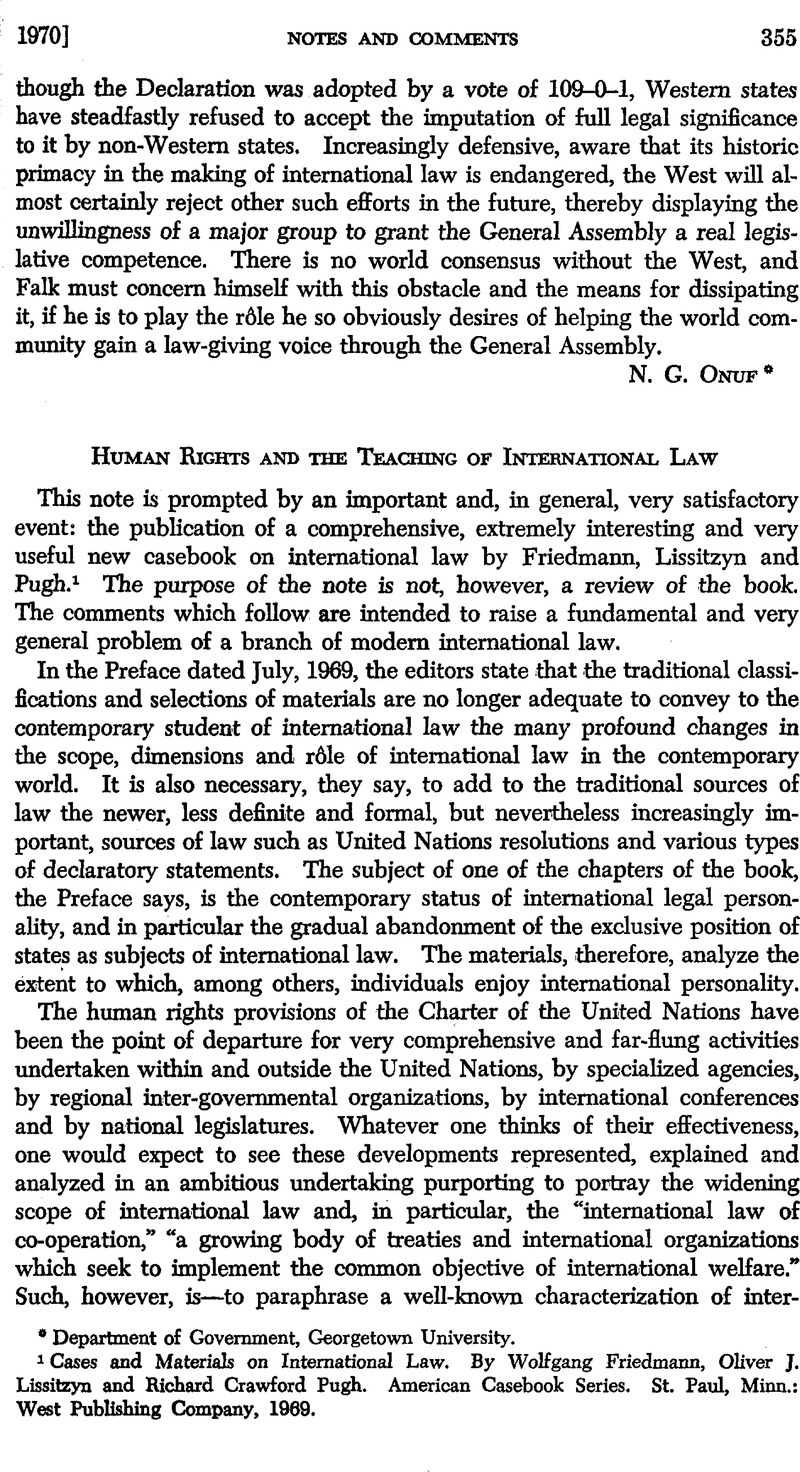No CrossRef data available.
Article contents
Human Rights and the Teaching of International Law
Published online by Cambridge University Press: 28 March 2017
Abstract

- Type
- Notes and Comments
- Information
- Copyright
- Copyright © American Society of International Law 1970
References
1 Cases and Materials on International Law. By Wolfgang Friedmann, , Oliver J. Lissitzyn, and Richard Crawford Pugh, . American Casebook Series. St. Paul, Minn.: West Publishing Company, 1969.Google Scholar
2 “The Misery and Grandeur of International Law.” By Georg Schwarzenberger, . An Inaugural Lecture delivered at University College, London. London: Stevens & Sons Ltd., 1964.Google Scholar
3 The text of the Universal Declaration of Human Rights and an extract from the European Convention on Human Rights are printed in the book (pp. 222 et seq.and 226 et seq.).
4 The four-volume work, The Strategy of World Order (1966), edited by Richard A. Falk and Saul H. Mendlovitz, is another example. Of its 2296 pages, about one and one-half pages (pp. 87-88 of its Vol. 2, International Law) touch in general terms upon the rights and interests of “individuals and corporate organizations.“
5 In the last years of his life Lauterpacht, in the light of subsequent events, qualified the negative attitude which he had taken towards the Declaration in his British Yearbook article of 1948 and in his 1950 book. See Schwelb, Human Rights and the International Community 75 (Chicago, 1964).
6 For a survey which is up to date as of Dec. 31, 1967, see the study by the Secretary General, “Measures taken within the United Nations in the Field of Human Rights,“ U.N. Doc. A/CONF. 32/5, pars. 25-57, and Add. 1, pars. 2-6. See also this writer's “The Influence of the Universal Declaration of Human Rights on International and National Law” in 1959 Proceedings of the American Society of International Law 217- 229; also op. cit.note 5 above, pp. 34-54; idem, in 8 Archiv des Völkerrechts 22-26 (1959), and in 14 ibid.14-22 (1966).
7 Friedmann, The Changing Structure of International Law 137 (1964).
8 The very careful reader will find at the end of the section “New processes of change“ the statement: “For another example of a ‘normative’ resolution see The Universal Declaration of Human Rights, infra… .“
9 “ … in the field of human rights as in other actual problems of international law it is necessary to avoid the Scylla of pessimistic cynicism and the Charybdis of mere wishful thinking and superficial optimism.” Josef L. Kunz in 43 A.J.I.L. 316 (1949).
10 Introduction to the Annual Report of the Secretary-General on the Work of the Organization, June 16, 1957-June 15, 1958, General Assembly, 13th Sess., Official Records, Supp. No. 1A (A/3844/Add. 1), p. 5.
11 Address delivered by the U. N. Secretary General, U Thant, in commemoration of the twentieth anniversary of the adoption of the Universal Declaration of Human Rights, in Final Act of the International Conference on Human Rights, Teheran, 1968, U.N. Doc. A/CONF.32/41 (U.N. Pub. Sales No.: E.68.XIV.2) at 34.
12 Sir Humphrey Waldock, General Course on Public International Law, 106 Hague Academy, Recueil des Course 32, 33, 198, 199 (1962-11).
13 Waldock, “Human Rights in Contemporary International Law and the Significance of the European Convention,” in The International and Comparative Law Quarterly, Supp. Pub. No. 11 (1965), pp. 13 and 15. For comments on the status of the Declaration, see also John P. Humphrey, “The United Nations Charter and The Universal Declaration of Human Rights,” in The International Protection of Human Rights 46-55 (Evan Luard, editor, London and New York, 1967), and the book and articles by this writer referred to in notes 5 and 6 above.
14 Law and Contemporary Problems 413 (1949).
15 See Francesco Capotorti, Patti Internazionali sui Diritti dell’ Uomo (Padua, 1967), part of which appeared in English in International Protection of Human Rights, Proceedings of the Seventh Nobel Symposium, Oslo, 1967 (Eide & Schou, editors). For other literature on the Covenants see 62 A.J.I.L. 835 (1968), note 39.
16 U.N. Doc. A/CONF.32/4, U.N. Pub. E.68.XIV.6.
17 TJenks's important comments on the self-determination article in Nobel Symposium (note 15), pp. 285-286, might have been brought to the reader's attention. The United Kingdom reservation to the article (Sept. 16, 1968) would appear to be a legitimate part of relevant “materials” on the question.
18 The United Kingdom accepted the compulsory jurisdiction of the European Court of Human Rights ten years later, in 1966. Greece never accepted it.
19 2 Yearbook of the European Convention on Human Rights 175-196 (1958-1959).


